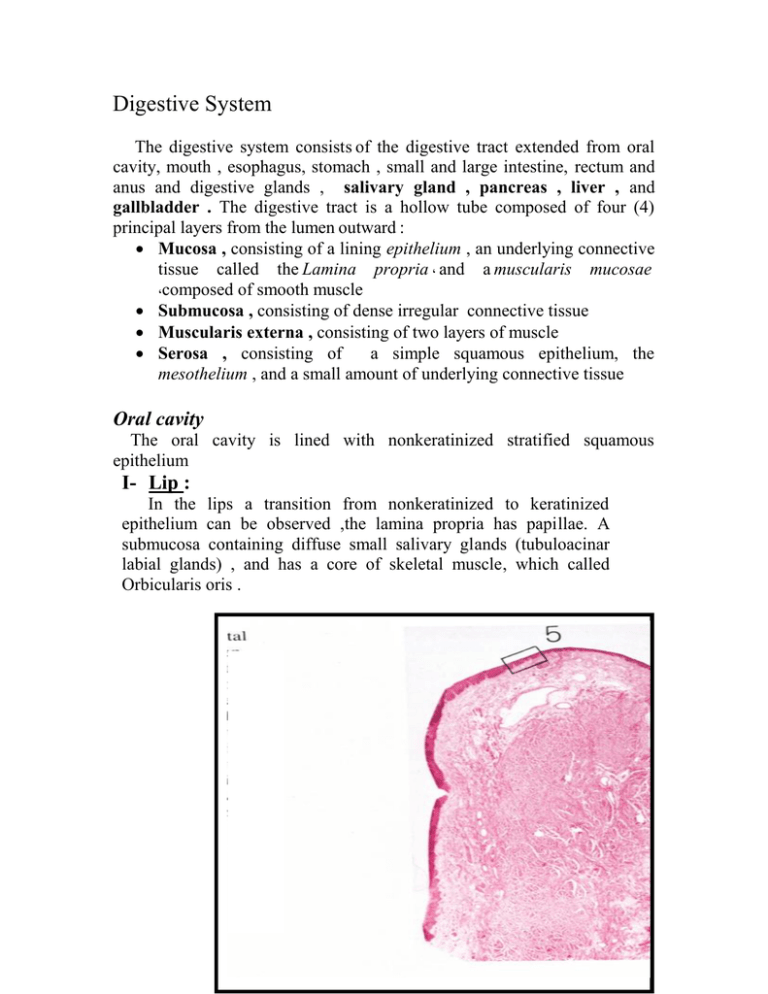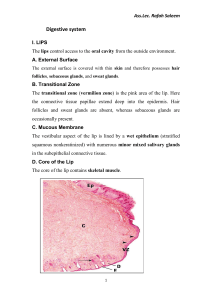Digestive System
advertisement

Digestive System The digestive system consists of the digestive tract extended from oral cavity, mouth , esophagus, stomach , small and large intestine, rectum and anus and digestive glands , salivary gland , pancreas , liver , and gallbladder . The digestive tract is a hollow tube composed of four (4) principal layers from the lumen outward : Mucosa , consisting of a lining epithelium , an underlying connective tissue called the Lamina propria , and a muscularis mucosae ,composed of smooth muscle Submucosa , consisting of dense irregular connective tissue Muscularis externa , consisting of two layers of muscle Serosa , consisting of a simple squamous epithelium, the mesothelium , and a small amount of underlying connective tissue Oral cavity The oral cavity is lined with nonkeratinized stratified squamous epithelium I- Lip : In the lips a transition from nonkeratinized to keratinized epithelium can be observed ,the lamina propria has papillae. A submucosa containing diffuse small salivary glands (tubuloacinar labial glands) , and has a core of skeletal muscle, which called Orbicularis oris . BV: venous blood vessels , EP: epithelium , HF: hair follicle, M: melanin pigment MC: meissners corpuscle , SG: stratum granulosum, SGl: sebaceous glands II- The tongue : Is a mass of striated muscle covered by a mucous membrane whose structure varies according to the region studied ,this allows the tongue great mobility for chewing and swallowing of food . The mucosa consists of : Epithelium (stratified squamous epithelial tissue) and thin papillated lamina propria . On the lower surface of the tongue , the mucous membrane is smooth , while the dorsal surface is irregular ,covered anteriorly by papillae , which are elevation of the oral epithelium and lamina propria .There are 4 types of papillae : Filiform papillae , have elongated conical shape ; numerous and present over the entire surface of the tongue. Fungiform papillae , these resemble mushrooms , they have a narrow stalk and a smooth surface, dilated upper part. These papillae contain scattered taste buds on their upper surfaces. Foliate papillae : These are poorly developed in humans Circumvallate papillae : These are extremely large circular papillae whose flattened surfaces extend above the other papillae and are distributed in the V region in the posterior portion of the tongue. Number of taste buds present along the sides of this papilla . Taste Buds In histological sections, taste buds appear as oval, palestianing bodies that extend through the thickness of the epithelium .A small opening onto the epithelial surface at the apex of the taste bud is called the taste pore . Taste buds are present in the lateral surface of the fungiform, foliate and circumvallate papillae . Are distinguished from the surrounding stratified epithelium by their oval shape & elongated cells , there are several types of cells in the taste buds : 1-Sustentacular (supporting) cells : Are elongated with a darker cytoplasm and slender dark nucleus . 2-Light taste or gustatory cells : A lighter cytoplasm and more oval lighter nucleus. 3-The basal cells : Are located at the periphery of the taste bud , near the basement membrane. CT: connective tissue, EP: epithelium , FP: filiform papillae, IL: inferior longitudinal muscles , SL: superior longitudinal muscle, V: vertical muscle CT: connective tissue , EP: epithelium , FP: filiform papillae , N: nerve CT: connective tissue , D: duct Gl: serous (Von Ebners) glands M: striated muscles bundles , TB: taste buds








